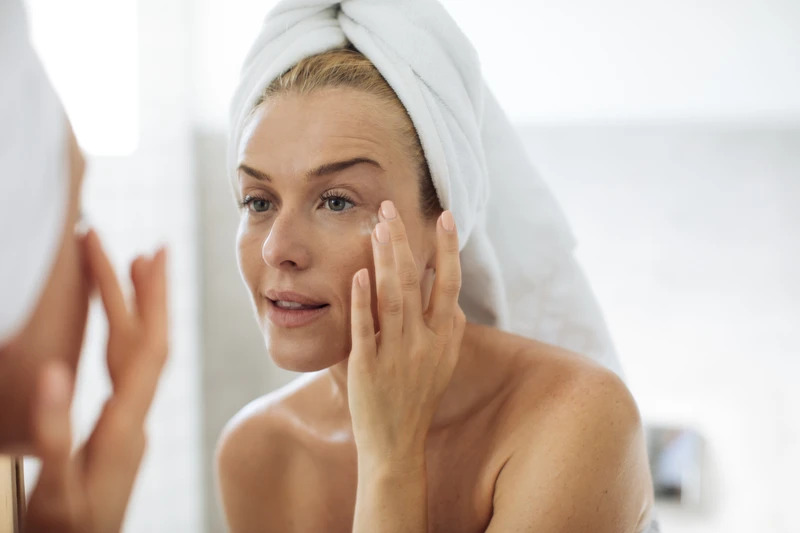If you wouldn’t eat it, you probably shouldn’t be putting it on your skin. We tend to be more cautious about what we put into our bodies versus what we put onto our bodies. Among many other reasons, this can be attributed to a lack of transparency regarding dangerous ingredients in personal care products. That’s where we come in.
There is no question that personal care products can penetrate our skin – remember, our skin is our largest organ. So, while skincare can help with anti-aging, sun damage, acne and more, using skincare that won’t increase your chemical body load can also help to greatly reduce your risk for infertility, endometriosis, early puberty, altered nervous system function, immune function, certain cancers, respiratory problems, metabolic issues, diabetes, obesity, cardiovascular problems, growth, neurological and learning disabilities, and many more.
These health risks are all associated with Endocrine Disrupting Chemicals (also known as EDCs).  These chemicals are found in many everyday products, including personal care products, cosmetics, some plastic bottles and containers, food-can liners, detergents, toys, and pesticides.
Skincare has become immensely popular in the last few years. The growth of the beauty industry has spawned a major demand for skincare as people have learned that in order to optimize your makeup routine, it’s important to take care of the foundation: your skin.
Your skin isn’t just a canvas for concealer, bronzer, blush, and highlighter (if that’s your thing).  Your skin is also a major foundation for your health that goes beyond a clear complexion and a little glow.
Your skin is made up of roughly five million pores that will absorb anything you put on your its surface. In fact, a study published in the American Journal of Public Health examined the skin’s absorption rates of chemicals found in drinking water. It showed that the skin absorbed an average of 64% of total contaminant dosage.
Over the past fifteen years, more than 10,000 Americans have had their blood tested by the U.S. Centers for Disease Control and Prevention (CDC) to try and determine their chemical body load (the amount of chemicals in the body at any given time). The results of the CDC study were truly astounding: even those who lived in remote areas were found to have hundreds of synthetic chemicals in their bloodstream.
We also know that the average woman puts on 12 products a day, which amounts to 168 unique chemicals. The average man puts on about 85 unique chemicals a day.  Even babies in utero are not immune.  Roughly 287 chemical toxins have been detected within the umbilical cord blood of newborns.
One of the many functions of the skin is, indeed, to be a barrier: it keeps our internal organs and fluids in, and harmful external elements out. The skin is comprised of three distinct parts: the epidermis, the dermis, and the hypodermis. The epidermis is comprised of five layers of dermal cells, the uppermost layer (also called the stratum corneum) being our first line of defense against the outside world. The stratum corneum is a sheath of flattened, dead skin cells surrounded by water-repelling lipids— this explains why our bodies don’t swell up like a sponge every time go swimming.
Though these outer layers of skin do a good job at keeping elements like water from seeping in, absorption of certain chemicals through the skin is very real. For example, many medicines are delivered through the skin, most often in the form of patches or gels. This method is quite potent and effective at delivering chemicals into our body.
The ease at which substances are absorbed into our skin depends on a number of factors, including the structure and size of the chemical applied to the skin. While a lot of chemicals are simply too big to be absorbed by the skin, others are just small enough. Some are even designed to penetrate the skin quickly and easily, like nanoparticles and “penetration enhancers†found in many lotions and sunscreens.
EDCs can penetrate the skin by passing directly through cells via permeation (intracellular), weaving their way between cells (intercellular), or by sneaking in through appendages like hair follicles or sweat ducts (transappendageal). If an EDC successfully passes through the upper layers of skin, it has the chance to be absorbed by the bloodstream and lymphatic system.
Harmful chemicals in personal care products can enter our bodies through non-dermal pathways as well. Some of the most common toxics are phthalates, which are often found in the ingredient “parfum†or “fragrance.†Phthalates can end up airborne, entering into our system through inhalation, depositing in airways, and being absorbed into the bloodstream through the lungs.
Skin care and cosmetic products can also be ingested. For years, studies have been finding heavy metals, like lead, in lipsticks and other lip products. People who reapply common lip products several times a day can ingest a significant amount of these ingredients, even surpassing the daily recommended exposure to some heavy metals.  It’s also possible to accidentally ingest facial products we apply close to our mouths, as well as products like shampoos and conditioners which often run down our faces while we’re in the shower.
If you’re like us, then learning about the damage that chemicals within our personal care products can cause will likely send you running to your bathroom to check out the ingredients listed in your products.
While we plan to give you a more detailed rundown of how to go about looking at labels (hint, hint – a spoiler for next week’s blog), it’s best to make sure your products do not contain artificial fragrances or colors, MEA, DEA or TEA, parabens, phthalates, PEG compounds, sulfates, silicones, or any other petrochemicals.
Now you may be thinking, “Okay, now that I know what I need to avoid, what should I be looking for to indicate that a product is hormone-safe?â€Â  The truth is that there are a lot of products out there and very little information. So, we get it – how are you expected to know what to fill your medicine cabinet with?
Hugh & Grace self-care products are a great place to start! Our products are always hormone-safe, meaning each product excludes known EDCs and are also designed to help detox, repair, and protect your skin from toxic chemicals and hormone disruptors.
Hugh & Grace self-care products are designed to work from the outside in. That is, we are hyper focused on the idea that what you put on your skin gets absorbed into your body and can have potentially detrimental effects on your health.
The best part is that by subscribing to hormone-safe self-care, you aren’t giving up any of the benefits that come with a regular skincare routine – you’ll still be glowing (inside and out!).  By committing to a few small changes in your daily skincare routine, you can optimize your hormone health by protecting, repairing, and restoring your skin against harmful chemicals.


